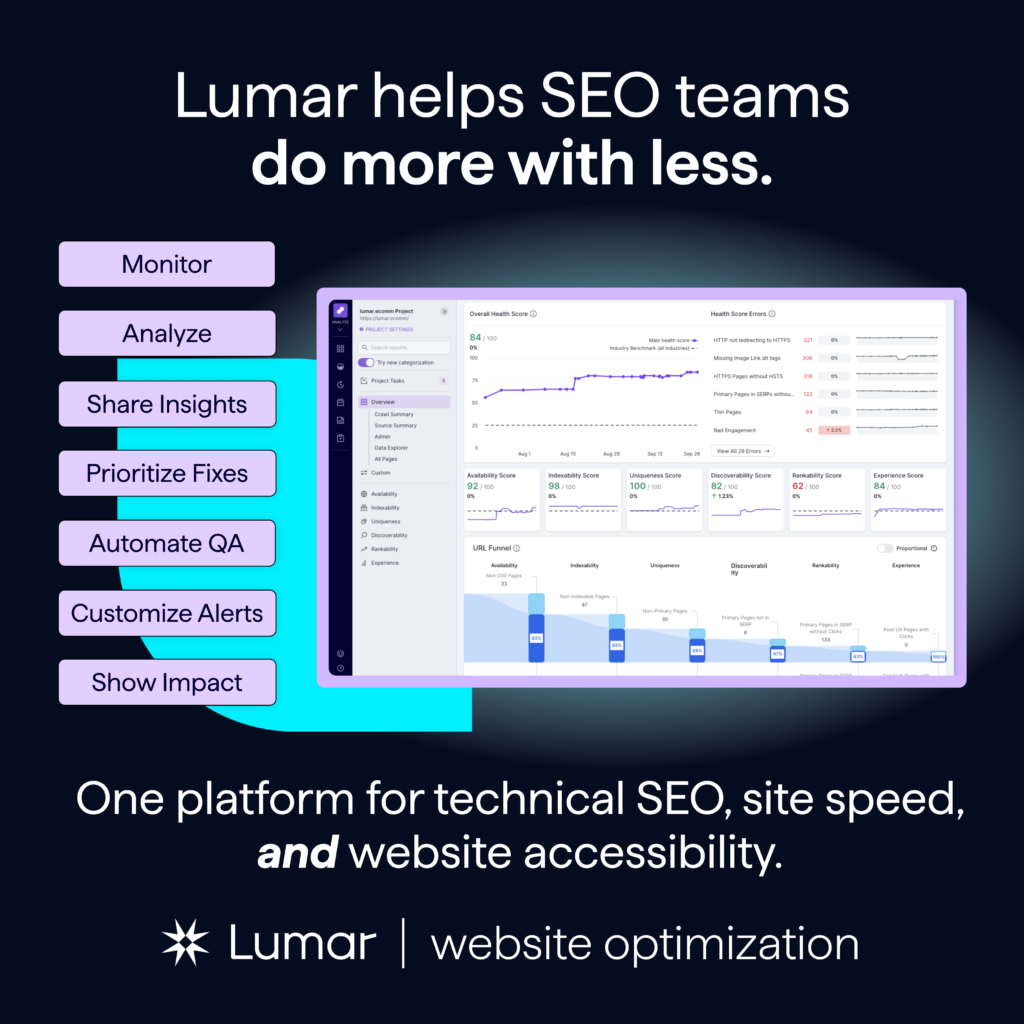How to scale SEO on large, multi-category sites
Join SEO experts Joe Fisher (Fisher SEO) and Chris Spann (Lumar) and dive into how to scale SEO on big, complex websites — watch the full Lumar webinar on-demand above.
Whether you’re in e-commerce, publishing, enterprise, or otherwise working on a large, multi-category site, you won’t want to miss this one!
In this SEO session, we cover:
- Site architecture when your site covers multiple categories
- How to structure your category pages
- How to optimize new pages on large websites
- Prioritizing SEO issues at scale
- and more!

Meet the Webinar Speakers
- Joe Fisher, SEO Consultant (Fisher SEO)
- Chris Spann (host) – Senior Technical SEO (Lumar SEO Pro Services)
Don’t miss the next Lumar webinar!
Sign up for our newsletter below to be alerted about upcoming webinars, or give us a follow on LinkedIn or Twitter/X to stay up-to-date with all the latest news in SEO and digital optimization.
Want even more SEO insights on-demand? Browse Lumar’s full library of SEO and website optimization webinars here.
Webinar Recap: SEO at Scale: Optimizing Large, Multi-Category Websites
Read on for our top takeaways from our “SEO at Scale” session, or watch the full webinar recording — including audience poll results and Q&A — above.
Defining large, multi-category websites and SEO at scale
In this session, we’re providing SEO tips for scaling search optimization on large, multi-category websites. So, let’s define exactly what we mean by that!
Multi-Category Websites:
Category pages—also known as product listing pages or collection pages—are the pages on your site that group related products, services, or offerings by shared attributes (like “red dresses,” “small business analytics,” or “Shopify marketing tools”). These pages function like the aisles in a physical store, guiding both users and search engines to relevant items.
Category pages account for 60% of organic revenue, according to Blink SEO data, making them essential for SEO performance.
In our webinar session, SEO consultant Joe Fisher defines multi-category sites as those with two or more categories (whether that’s products, services, or software).
Large Websites:
When we talk about large websites, we’re talking about sites with more than 10,000 pages. Often, these are enterprise websites, e-commerce sites, or news websites.
SEO at Scale:
Scaling SEO refers to the process of growing a website’s organic search visibility in a sustainable, systematic way across thousands of pages. It focuses on achieving high keyword and topic coverage that hasn’t yet been fully realized, while maintaining quality, avoiding duplication, and ensuring technical SEO best practices are followed. The goal is to drive consistent, long-term traffic growth without sacrificing performance or user experience.
Example of a large, multi-category site:
IKEA’s e-commerce website is a good example of a large, multi-category site. It boasts multiple categories across furniture (sofas, chairs, tables, etc.), which are further categorized by colour, room type, brand, and more.


Common mistakes in multi-category SEO
1. Thin Categories:
Creating a new category for just one or two products isn’t sufficient. If you also lack expertise to produce relevant content, the page won’t serve users, or rank well in SERPs.
According to our webinar guest, SEO consultant Joe Fisher, the existence of every category page needs to be justified and helpful to users. Search engines are not likely to reward ‘thin’ category pages that appear to only have been created for SEO purposes.
2. Duplicate or Overlapping Category Pages:
Having duplicate or highly similar content across multiple category pages can lead to keyword cannibalization.
Fisher notes this issue is increasing with the rise of programmatic SEO and AI-generated content.
As Fisher puts it: “Imagine if you walked into a store and you saw the same red dress 10 times but with different labels on it.” Duplicating content, or only slightly repositioning it, especially on product pages, can confuse both users and search engines.
3. No Current Organic Standing for Potential Sub-Category Pages in Parent Category:
If you’re considering building out a new subcategory page, you may want to first check whether any related queries for that subcategory are already getting any impressions in GSC on the parent category page. If not, says Fisher, the subcategory page may not be worth developing just yet.
“This isn’t so much of a mistake, but it suggests an environment where the [proposed new subcategory] page can’t thrive as easily as others,” says Fisher.
“So if there’s no current organic standing for the [potential subcategory] queries, no impressions for the desired queries in Search Console for the parent pages — what I mean by that is, say you’ve got a dresses category and it’s got red dresses in there. It might have one red dress in there, but it’s getting zero impressions for ‘red dresses’. Google’s crawlers and algorithms are clever enough now to determine the intent of a page and contextualize it, so it should start to trickle in with a few impressions for these potential sub-category pages. If it’s not done that, then there may not be much potential [for the subcategory page].”
4. Too-Broad Category Keywords & Poor Site Structure:
The issues of ‘too-broad keywords’ and ‘poor site structure’ often go hand-in-hand. Broad category keywords face intense competition in the SERPs — and often may not be linked in your site navigation, which hurts crawlability.
For example: a “dining tables” category might be too broad to rank or justify taking up space in the main nav.
Creating new pages or entry points
Fisher highlights that creating new pages (entry points) can be a high-reward, low-risk tactic for scaling SEO performance on large, multi-category websites.
Benefits of adding new pages / new entry points on a complex website:
- Helps clarify product/service positioning to both users and search engines.
- Targets high-intent keywords you don’t currently rank for.
- Doesn’t require new products/services.
- Provides measurable value to stakeholders via GSC data.
“You don’t have to develop any new services. You don’t have to develop any new products or any new software. So you’re not reinventing the wheel when it comes to the actual business. It’s purely just more of a positioning exercise,” explains Fisher.
But, he points out, there’s no real point in adding new pages / additional entry points until you’ve looked at the current taxonomy and structure of the site and addressed the existing SEO issues.
How to scale SEO on multi-category websites
Step 1: Audit & fix your existing categories and site structure
Before adding new pages or categories to your site, start by auditing and fixing what’s already there.
When it comes to the SEO auditing phase on large e-commerce websites, Fisher suggests:
- Export a list of all of your current products and the categories they are currently in.
- Assess how similar and low on content your category pages are. Rewrite or add to these category pages if they are too similar or thin on content.
- Ask: Are there any pages that are not linked to properly? Any duplicates? Use a good, enterprise-scale website crawler to check for orphaned pages or duplicate content.
Step 2: Add new (justified!) entry points (don’t just add new pages for the sake of it)
When you’re ready to start creating new entry points on your site to boost SEO, Fisher has several recommendations for creating new categories and pages, broken down by industry:
For multi-category e-commerce sites:
- Only add new categories/subcategories if you have at least 3+ unique products to include in that category.
- Check if GSC shows existing impressions for relevant subcategory queries under its parent category — ideally, you’ll have at least a few existing impressions for the subcategory before building it a dedicated site section.
- Check that there is low competition in the SERPs for the new category or subcategory page you’re building. (Fisher recommends manually checking that some of the existing top result pages have weak content that you’ll be likely to outrank with your new page.)
- Product listings within a category should be at least 15% different from every other category/collection on your site. If 9 out of 10 products in a category are identical to the products showing up in another category, you may as well optimize the existing category page instead.
For multi-category service sites:
- Consider creating new landing pages for a service or industry.
- Check if you’re already receiving impressions in Google Search Console for queries on the parent service page (not in the top 20).
- Check that there is low competition in the SERPs for the new category or subcategory page you’re building. (Check for high-ranking competitor pages with weak content.)
- Remember: You need to have *GENUINE* experience with any service or industry that you could write case studies about.
For multi-category SaaS sites:
- Consider creating new landing pages for software or an industry.
- Check if you’re already receiving impressions in Google Search Console for queries on the parent service page (not in the top 20).
- Check that there is low competition in the SERPs for the new category or subcategory page you’re building. (Check for high-ranking competitor pages with weak content.)
- Again, you must have *GENUINE* experience with this software or industry that you could write case studies about.
Examples of scaling SEO on large multi-category sites
For several real-life examples of scaling SEO on large multi-category sites, pick up the webinar session replay video here:
Ready to scale SEO on your multi-category site? Try Lumar.
If you’re feeling inspired to start scaling your SEO efforts on your own multi-category site, give Lumar a try.
Our comprehensive technical SEO and website optimization platform — powered by our ultra-fast, scalable website crawler — was built to handle exactly these sorts of large-scale sites.



